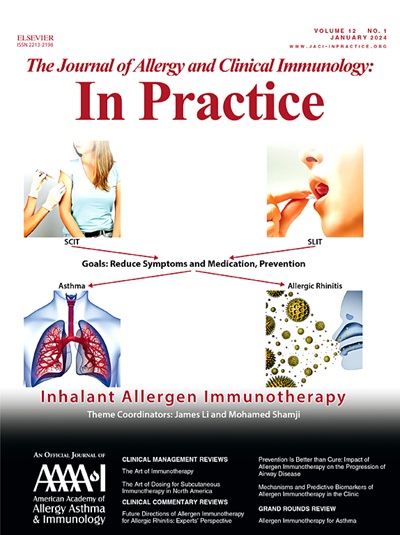Hereditary α-tryptasemia is Associated With Anaphylaxis to Antibiotics and Monoclonal Antibodies
IF 8.2
1区 医学
Q1 ALLERGY
Journal of Allergy and Clinical Immunology-In Practice
Pub Date : 2025-06-01
DOI:10.1016/j.jaip.2025.04.013
引用次数: 0
Abstract
Background
Hereditary α-tryptasemia, a genetic trait caused by increased α-tryptase copy number, is associated with idiopathic and venom anaphylaxis.
Objective
We aimed to determine the impact of tryptase genotypes on drug-induced anaphylaxis.
Methods
A prospective discovery cohort of 99 patients from a referral center in Slovenia with acute anaphylaxis to drugs underwent tryptase genotyping by droplet digital PCR. For validation, we included a cohort of 26 patients from the Czech Republic. Associated inciting agents and the severity of the reactions were subsequently examined.
Results
Hereditary α-tryptasemia was associated with drug-induced anaphylaxis with a prevalence of 13% (n = 13 of 99) in the discovery cohort and 15% in the validation cohort (n = 4 of 26). Hereditary α-tryptasemia was identified in every individual with elevated basal serum tryptase levels (11.6-21.9 ng/mL; n = 14) within both cohorts of patients. Hereditary α-tryptasemia was more prevalent in individuals with antibiotic- or mAb-induced anaphylaxis in both the discovery and validation cohorts (n = 13 of 51; 26%) compared to those with anaphylaxis resulting from neuromuscular blocking agents, nonsteroidal anti-inflammatory drugs, contrast, chlorhexidine, or other drugs (n = 5 of 74; 7%; P = .02; odds ratio = 4.1; 95% CI, 1.3-11.1). Overall, we found fewer individuals with no ⍺-tryptase than in the general population, and there was a trend for subjects with more ⍺-tryptase copies to have more severe reactions. Thus, among subjects with three ⍺-tryptase copies, the prevalence of severe anaphylaxis was 73%, compared with 59% with one to two ⍺-tryptase copies and 58% for subjects without ⍺-tryptase.
Conclusions
Risk for anaphylaxis to antibiotics and biologics is associated with inherited differences in α-tryptase–encoding copies at Tryptase α/β1.
遗传性α-胰蛋白酶血症与抗生素和单克隆抗体过敏反应有关。
背景:遗传性α-胰蛋白酶血症是一种由α-胰蛋白酶拷贝数增加引起的遗传性状,与特发性和毒液过敏反应有关。目的:探讨胰蛋白酶基因型对药物性过敏反应的影响。方法:对来自斯洛文尼亚转诊中心的99例药物急性过敏反应患者进行前瞻性发现队列,采用微滴数字PCR进行胰蛋白酶基因分型。为了验证,我们纳入了来自捷克共和国的26例患者。随后检查了相关的刺激剂和反应的严重程度。结果:遗传性α-胰蛋白酶血症与药物性过敏反应相关,在发现队列中患病率为13% (n = 13 / 99),在验证队列中患病率为15% (n = 4 / 26)。遗传性α-胰蛋白酶血症在每个个体中都被鉴定为基础血清胰蛋白酶水平升高(11.6-21.9 ng/mL;两组患者中N = 14)。在发现和验证队列中,遗传性α-胰蛋白酶血症在抗生素或单克隆抗体诱导的过敏反应个体中更为普遍(n = 13 / 51;26%)与神经肌肉阻滞剂、非甾体抗炎药、对比剂、氯己定或其他药物引起的过敏反应相比(n = 5 / 74;7%;P = .02;优势比= 4.1;95% ci, 1.3-11.1)。总的来说,我们发现与一般人群相比,没有携带胰蛋白酶的个体更少,并且有一种趋势,即携带更多的胰蛋白酶拷贝的受试者有更严重的反应。因此,在有3个复制的受试者中,严重过敏反应的患病率为73%,而有1到2个复制的受试者为59%,没有复制的受试者为58%。结论:对抗生素和生物制剂过敏反应的风险与α-胰蛋白酶α/β1编码拷贝的遗传差异有关。
本文章由计算机程序翻译,如有差异,请以英文原文为准。
求助全文
约1分钟内获得全文
求助全文
来源期刊

Journal of Allergy and Clinical Immunology-In Practice
ALLERGYIMMUNOLOGY-IMMUNOLOGY
CiteScore
11.10
自引率
9.60%
发文量
683
审稿时长
50 days
期刊介绍:
JACI: In Practice is an official publication of the American Academy of Allergy, Asthma & Immunology (AAAAI). It is a companion title to The Journal of Allergy and Clinical Immunology, and it aims to provide timely clinical papers, case reports, and management recommendations to clinical allergists and other physicians dealing with allergic and immunologic diseases in their practice. The mission of JACI: In Practice is to offer valid and impactful information that supports evidence-based clinical decisions in the diagnosis and management of asthma, allergies, immunologic conditions, and related diseases.
This journal publishes articles on various conditions treated by allergist-immunologists, including food allergy, respiratory disorders (such as asthma, rhinitis, nasal polyps, sinusitis, cough, ABPA, and hypersensitivity pneumonitis), drug allergy, insect sting allergy, anaphylaxis, dermatologic disorders (such as atopic dermatitis, contact dermatitis, urticaria, angioedema, and HAE), immunodeficiency, autoinflammatory syndromes, eosinophilic disorders, and mast cell disorders.
The focus of the journal is on providing cutting-edge clinical information that practitioners can use in their everyday practice or to acquire new knowledge and skills for the benefit of their patients. However, mechanistic or translational studies without immediate or near future clinical relevance, as well as animal studies, are not within the scope of the journal.
 求助内容:
求助内容: 应助结果提醒方式:
应助结果提醒方式:


